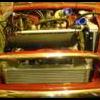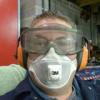Minimum Chamber Volume? How Big A Skim?
#1

Posted 17 March 2012 - 01:29 PM
its very similar in both heads at 22cc in the new one, and 22.5/23cc in my old head.
however, i have the 21252 +0.040" pistons in my engine with a 8.4cc dished crown, and a dec height of 0.076", with a standard stroke.
this all works out to about 8.6:1 cr, which on a naturally aspirated engine, isnt good for performance.
having said that the car is remarkably quick, and i have used it all last year for track days etc. i have always just trusted the engine was asssembled and calculations done correctly by the previous owner/builder.
my problem is, i need to get the head down to about 16cc to get the compression ration near 10:1 which i believe is what i need.
can this be done? or am i risking breaking into galleries in the head etc?
stripping the engine and machining the top of the block back isnt an option sadly, HELP!!!!!
#2

Posted 17 March 2012 - 01:58 PM
16cc seems like a very low target. I think the head on my car's engine has 19cc to 20cc chambers (it's been a long time though... so I could be remembering wrong). I have the same pistons as you and the block is currently at +.060
#3

Posted 17 March 2012 - 02:32 PM
i did check the pistons on the minispares site, as they still list them. it does state they have a 8.4cc dish, and that "typical" fitment will produce 8.8:1cr
#4

Posted 17 March 2012 - 02:33 PM
I assume you are using a piece of clear plastic (Plexiglass for me... Perspex for you?) with a hole drilled in it over the chamber. Stop filling the chamber when the last bubble comes out of the hole in the plastic.
As he mentions above, it will be hard to get an accurate reading without the plastic because of the liquid's surface tension. The alcohol and food coloring will help resolve the meniscus issue inside the buret.
Edited by dklawson, 17 March 2012 - 02:47 PM.
#5

Posted 17 March 2012 - 02:38 PM
Ive certainly seen a swiftune race head at just over 15cc that was for use on a 999cc racer.
#6

Posted 17 March 2012 - 02:48 PM
I have edited my last post to clarify my point.
#7

Posted 17 March 2012 - 02:56 PM
Indeed doug, but that small area goes all the way around the chamber shape............
???
No, it doesn't. You are supposed to "angle" the head slightly on the bench such that the hole in the plastic covering the chamber is at the high point and edge of the chamber. When you fill the chamber the water wets both the chamber and the plastic leaving no air and therefore, no meniscus. If you fail to incline the head then I am sure you will trap air below the plastic plate which will appear as a meniscus... but is really trapped air.
#8

Posted 17 March 2012 - 03:04 PM
fortuneatly, both the heads are earlier pre a plus types with the flat upper face. the original one was a 12g1805 head actually.
#9

Posted 17 March 2012 - 03:10 PM
There will be no meniscus between the plastic plate and the chamber when the CCing is done with the head angled and no air trapped. The effect of the meniscus volume in the hole of the plastic plate is lower than most people's ability to accurately measure.
Consider a 4mm hole in a 3mm thick plate (with no countersink). The volume of the entire hole is less than 0.04 cc... that is less than 1/2 division on a typical buret. That 0.04 cc figure is based on the difference of the fluid just touching the hole entrance... and the hole in the plate being full to the top... not a likely range. Most people would stop as soon as the fluid removes the last bubble from under the plastic.
I would be more concerned with the effect of the meniscus inside the buret but even there if you are consistent in your reading method and use the dye in the liquid you will end up with very accurate results.
#10

Posted 17 March 2012 - 03:33 PM
Let us be clear here. Are you talking about the meniscus in the buret or the one in the hole of the plastic plate?
Earlier you said there will be a meniscus all the way around the chamber. With the plate affixed and the head angled, there will not be a meniscus around the chamber. Therefore, no contribution (good or bad) to the chamber volume measurement.
In the hole of the plastic plate there can be a meniscus but if the measurements are performed consistently its contribution to the resulting value is not significant. (.04cc / 22cc x 100% = 0.18% WORST CASE... well below what will be typical measurement error).
What is more important is accurately and consistently 1) filling the chamber and 2) reading the fluid level in the buret relative to the meniscus in the column. Further to this, devices like burets are calibrated for a specific fluid (typically water) to account for surface tension and the formation of the meniscus. Again, not my opinion, just the way it is. Some people use light oil for CCing chambers... to each his own as long as their measurements are consistent and repeatable.
Cradley, sorry about the hijack, back to your original topic now. It sounds like you were making the measurements correctly. However, to improve your confidence in the measurements you may want to repeat the tests a few times and average the results. Incidentally, you can also CC the dished piston volume using the same technique you used for the chambers.
#11

Posted 17 March 2012 - 04:05 PM
#12

Posted 17 March 2012 - 04:06 PM
has anyone achieved the size of skim im talking about here, i need to get down to 16cc if possible. im pretty sure my measurements were accurate, as are my maths.
#13

Posted 17 March 2012 - 05:34 PM
AC
#14

Posted 17 March 2012 - 05:37 PM
You need to determine whether the head has been skimmed earlier in its life. If it hasn't, then it's safe to take 0.060" off, especially if it's a pre A+ 12G940 head casting. If you think about those radically re-shaped combustion chambers that some full-race heads have with a very high C.R. then it seems as though more than 0.060" has probably been removed. Sorry I can't be more confident, but the good news is that if you do go too far and end up with a damaged head, it's nbot expensive to get another casting and just re-build the existing valves, springs, etc. into it. I have some spare pre-A+ 12G940 castings if you do have a problem.
Obviously the best solution is to use 21253 pistons which have a higher crown height relative to gudgeon pin centre which will solve it for you.
Edited by Cooperman, 17 March 2012 - 05:38 PM.
#15

Posted 17 March 2012 - 09:07 PM
sadly, at this stage taking the engine appart and swapping pistons etc isnt an option as the car is my daily driver, despite it being a rather impractical one!
i think i may have my old head skimmed down as much as i dare, and see about building another engine, and just keep my new head for that.
1 user(s) are reading this topic
0 members, 1 guests, 0 anonymous users

















